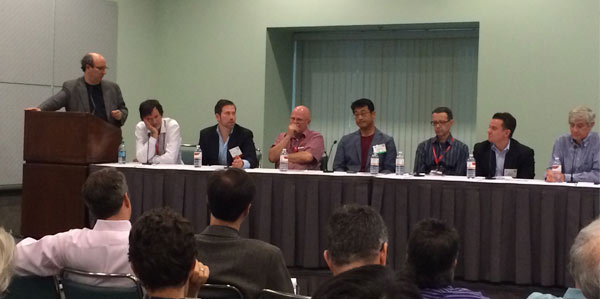HRA Sessions at AES Day 1
I made it to the first session of the DEG/AES co-sponsored high-resolution sessions a little late yesterday. I had problems with parking and they didn’t have my registration for the sessions correct.
The first session was entitled “Hi-Res Audio Devices for Every Lifestyle” and featured Astell & Kern, dCS, DTS, Kimber Kable, Meridian, Mytek and Sony. The panelists answered questions about the marketplace, the advantages of high-resolution music, and gave some of their thoughts about the direction things are going. The assembled panel was very diverse and included companies making portable high-resolution players (Sony, A&K), music servers (Sony, Meridian, dCs) and my good friend Ray Kimber…a very successful manufacturer of high-end cables. I’m not really sure how a cable company got invited to a panel on high-resolution devices, but maybe there are high-resolution electrons moving smoothly through Ray’s headphone cables.
The “New Business of Hi-Res Music” was the least interesting panel of the day. Maybe it’s because I’ve seen the exact same presentation with the same people before. What was very interesting was the numbers that they shared. When asked, “How many high-resolution albums has your company released thus far?” Jim Belcher of Universal Music put the number at 1300. Mark Piibe gave the exact same number at Sony Music follow by Howie Singer from WB Records who put the number at 1200. That means that there are less than 5000 “so-called” high-resolution albums available through HDTracks, Acoustic Sounds, Qobuz, and HighResMusic. It’s true that there are probably another 5000 available from independent labels…but it should be pretty obvious that the number is not huge. And it’s not getting bigger very quickly. There’s real work to be done inside of the labels to identify the masters and to the transfers and remastering. I spoke briefly to a big shot a WB in the hall and he said they are struggling to get the provenance together for the tracks as well.
If you were going to go in to the high-resolution download business and could provide a catalog of less the 5000 titles, do you think you could raise $10 million dollars on the idea? Of course not. You’d need very big numbers…something in the neighborhood of 20 million or more. But what if those tracks were merely rips of standard resolution CDs? How far do think that business would take you? Not very far would be my guess.
And the truth of the matter is that the 5000 tracks that are being systematically transferred and remastered are old analog tapes (which aren’t high-definition…unless you accept the twisted definition provided by the DEG, CEA, NARAS, and major labels) are standard resolution tracks! These should be called “Master Quality” or “Studio Masters” because they don’t meet the specifications of the JAS and the Hi-Res Audio logo. This deliberate misnaming of things has been created to make you all believe that these new masters are going to be dramatically better than what has been delivered in the past. It’s not true. They’re as good as they will ever be…but they’re not Hi-Res Audio.
Someone should begin to take an inventory on the number of actual high-resolution audio releases available. If I had to guess I would put the number at around 2000. And I would be generous and include any native DSD recordings in that number.
I’ve got to run off to the show today. The AES working group on High-Resolution Audio is meeting today…and I’m a member. I don’t hold out much hope that the AES will improve things much. But I have to remember to never say never.
To be continued…


Hi Mark, You’re being generous. The hi-res “definition” you speak of is not just inaccurate, it’s deceptive, particularly in the use of the word “quality” in any of the four categories presented with that definition.
Consumers need a more disciplined description that addresses quantifiable standards rather than the industry’s marketing needs. Given the strangely defensive attitude of some of the drafters of that flawed document, I doubt we’ll have a forthright document soon.
Another suggestion instead of fighting the CEA and major labels: go around them with a major standards body, specifically the ITU, to develop a robust definition for high resolution/high quality recordings.
The ITU may not seem like the right body, but I think they are, or at least the best fit I can find. Look at the nature of the standards they’ve developed, for example http://www.itu.int/pub/R-REP-BS/en and http://www.itu.int/rec/R-REC-BS/en. They’ve addressed many difficult topics that are relevant for areas that go far beyond just broadcasting.
It strikes me that the issue of a robust definition of the quality of the recording being broadcast (prior to any broadcast-specific processing) would be something of interest to the ITU, and definable in a way that does exactly what you want it to do, Mark, for defining the quality of recordings as distributed for playback prior to consumer playback processing.
Of course, you may have already been thinking of this option and it didn’t work out, but if not, it seems worth a meeting with or a call to the right ITU person to explore it. To the extent that the ITU is opportunistic in looking for ways to add value within their broad scope, pointing out the complete market failure of the industry to robustly define HRA itself can be leveraged to help make the case for their involvement.
I don’t know anyone at the ITU, so I can only make work for others on this 🙂 But seriously, I spent many years in my early career trying to knock down barriers, and it took me a while to figure out that going around them is frequently far more effective…
This might serve as an alternative means of getting some rigor in the definition. My bets are on the JAS and the logo right now…we’ll see.